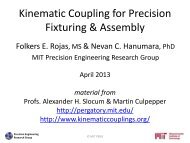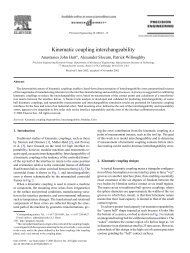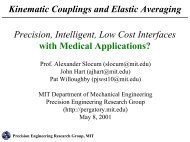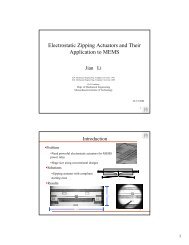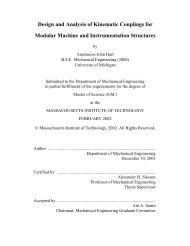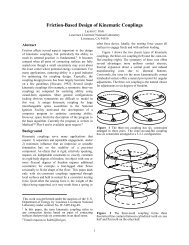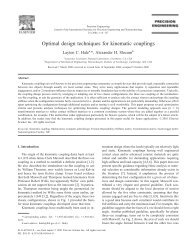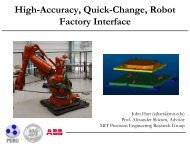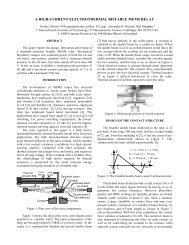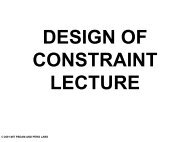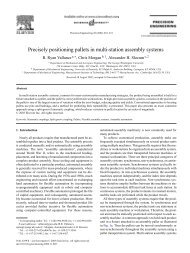Design of a Hybrid Positioner-Fixture for Six-axis Nanopositioning ...
Design of a Hybrid Positioner-Fixture for Six-axis Nanopositioning ...
Design of a Hybrid Positioner-Fixture for Six-axis Nanopositioning ...
Create successful ePaper yourself
Turn your PDF publications into a flip-book with our unique Google optimized e-Paper software.
<strong>Design</strong> <strong>of</strong> a <strong>Hybrid</strong> <strong>Positioner</strong>-<strong>Fixture</strong> <strong>for</strong> <strong>Six</strong>-<strong>axis</strong> <strong>Nanopositioning</strong> and Precision FixturingSubmitted to Precision Engineering0.9980.013 0.025 0.016 1.000 0.004 0.001 0.007C (31) 0.184 0.950 0.182 1.002 0.016 0.023 0.1740.036 0.0231.0000.6230.110 0.0060.0160.171 0.0310.0010.019 0.003 0.009 0.0200.0011.002 0.0070.0000.003 0.029The improvement due to calibration will depend upon the quality <strong>of</strong> the line fit. Equation 32 shows theR 2 values <strong>for</strong> the calibration. The values R ij correspond to the quality <strong>of</strong> the line fit <strong>for</strong> C ij .1.0000.7541.0020.614 0.639 1.000 0.929 0.997 0.876R (32)0.705 0.963 0.940 1.000 0.785 0.8350.3180.4510.9861.0000.9940.9500.9660.9980.9830.7980.9531.0000.5780.8581.0000.7841.0000.9190.9940.9930.8621.000The errors in the HPF prototype post calibration are listed in Table 4. The first data set indicates howwell the HPF positions <strong>for</strong> a commanded single-<strong>axis</strong> move. The second set looks at the parasitic errors<strong>for</strong> all commanded displacements. In both sets, the numbers in the row labeled “Maximum” are themaximums <strong>of</strong> the absolute value <strong>of</strong> the respective error sets.Table 4: HPF positioning errors post calibrationX Y[nm] [nm]Z[nm]x[radian]y[radian]COMMAND DISPLACEMENT1 14 34 26 0.5 0.4 0.2Maximum 36 93 74 1.6 1.0 0.5z[radian]PARASITIC DISPLACEMENTS1 40 50 321 2.2 1.7 0.7Maximum 140 195 1032 7.4 8.8 2.5The parasitic errors are clearly <strong>of</strong> more concern than the errors in commanded position. In particular, theparasitic errors in the Z <strong>axis</strong> are significantly larger than those in X and Y. The Z errors are larger as thereis poor correlation between command values and some <strong>of</strong> the non-calibrated parasitic Z errors. This canbe seen by inspecting the third row <strong>of</strong> the R matrix. Other parasitic errors (other rows) have several lowR ij values; however the magnitude <strong>of</strong> the errors <strong>for</strong> their good (near unity) R ij values is lower than those<strong>for</strong> Z parasitic errors. A direct link between the hardware and the large magnitude/poor correlation <strong>of</strong> Z20



